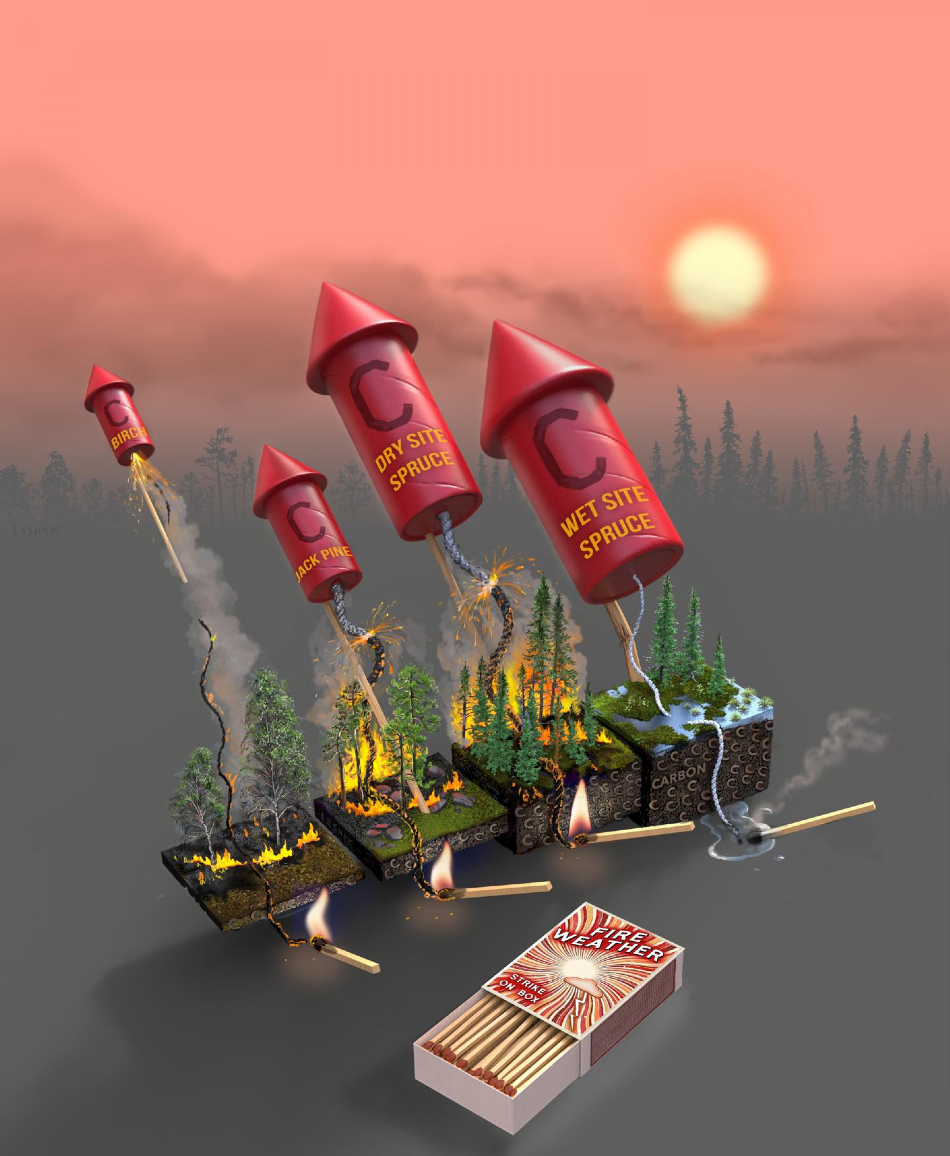Oct 13 2020
With climate warming triggering longer fire seasons and more devastating fires in the North American boreal forest, the ability to measure how much carbon each fire burns has become more critical.
 Rockets represent carbon stored in wood, trees, and soil in four main boreal forest regions. Though fire weather helps “ignite” the rockets, the amount of emissions each forest can produce is determined by fuel load (soil layers) and flammability (soil moisture). Image Credit: Victor Leshyk, Center for Ecosystem Science and Society.
Rockets represent carbon stored in wood, trees, and soil in four main boreal forest regions. Though fire weather helps “ignite” the rockets, the amount of emissions each forest can produce is determined by fuel load (soil layers) and flammability (soil moisture). Image Credit: Victor Leshyk, Center for Ecosystem Science and Society.
A recent study headed by Northern Arizona University and published recently in Nature Climate Change proposes that the amount of carbon burnt is subject more to the availability of fuels than to fire weather such as temperature, drought situations, or rain.
As part of a large retrospective study that covered Canada and Alaska, an international group of scientists discovered that the carbon deposited belowground in soil organic matter was the most significant predictor of the amount of carbon a fire will discharge.
The team studied the massive Western Boreal’s diverse forest conditions by examining field data obtained from 417 burn sites in six ecoregions in Alaska and Canada between 2004 and 2015. They learned that the volume of carbon stored in soils was the main predictor of how much carbon would burn, and that soil moisture was also important in predicting carbon emission.
In these northern forests, soil, not trees, can account for up to 90 percent of carbon emissions, so we expected that these organic soils would be a significant driver. But we were surprised that fire weather and the time of year a fire starts proved to be poor indicators of carbon combustion. It’s really about the fuels that are there when a fire starts.
Xanthe Walker, Study Lead Author, Center for Ecosystem Science and Society, Northern Arizona University
That is a key finding, since fire weather, as quantified by a Fire Weather Index, is one of the chief tools researchers and fire managers use at present to model carbon emissions in these boreal forests. This research proposes that fuels must form a bigger part of those models.
When we think of climate change and wildfires, we often instinctively think of extreme weather conditions. But our study shows that vegetation also matters--a lot! Predicting future vegetation is a tough nut to crack, but this study emphasizes the need to keep chipping away at it.
Marc-André Parisien, Study Co-Author and Research Scientist, Canadian Forest Service
The vegetation patterns they exposed were complex—tree species composition, soil moisture, and stand age during fire all acted together to predict combustion extent. For example, extremely flammable black spruce was mostly a predictor of carbon combustion, and the occurrence of this species grew with site moisture and stand age during a fire. But such interactions could probably differ with the climate.
For instance, with warming climate and reduction in fire intervals, black spruce stands are being replaced by jack pine and deciduous trees, which grow in shallower soils that emit less carbon during fires. The study’s site-level resolution enabled the team to capture such dynamism in carbon burning patterns and provides clues about the way they may change in the future.
We really need to move beyond the misconception of the boreal forest as a monotonous stretch of forest. While only a few tree species occur in the boreal forest, its diversity in ecosystem structure, forest age, topography, peatland occurrence and permafrost conditions is enormous, and our paper shows that these features dictate the carbon emissions from boreal fires.
Sander Veraverbeke, Study Co-Author and Assistant Professor, Vrije Universiteit, Amsterdam
Veraverbeke added, “The good news is that we can map aspects of this fine-scale ecosystem variation with current tools from NASA and other space agencies. Now we need to do this at the continental scale.”
The level of insights this research has provided gives modelers a framework for raising further questions related to carbon, noted Michelle Mack, senior author on the research and professor of biology at Northern Arizona University.
Mack said, “In the past, fire models have focused on fire behavior, not carbon emissions. It’s only been in the last decade or so that we’ve seen a global effort to quantify how much carbon these fires are releasing. We hope that our observations about fuels will inform the models as we work to better understand the boreal forest’s emission trajectory.”
Parisien supported the statement. “We are figuring out that fire-vegetation feedbacks a lot stronger than we thought they were just a few years ago,” he said. “Of course, we’ll never be able to manage all of the vast boreal biome--nor should we want to—but this helps us know what targeted actions, such as fire management or modifying forest vegetation, we can take to limit carbon loss.”
Journal Reference:
Walker, X. J., et al. (2020) Fuel availability not fire weather controls boreal wildfire severity and carbon emissions. Nature Climate Change. doi.org/10.1038/s41558-020-00920-8.